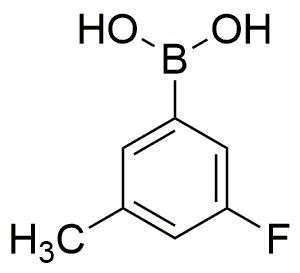3-Fluoro-5-methylphenylboronic acid is widely utilized in research focused on:
- Pharmaceutical Development: This compound serves as a key intermediate in the synthesis of various pharmaceuticals, particularly in the development of drugs targeting cancer and other diseases. Its unique structure allows for the creation of more effective therapeutic agents.
- Organic Synthesis: It is employed in cross-coupling reactions, such as Suzuki-Miyaura coupling, which are essential for forming carbon-carbon bonds in organic chemistry. This application is crucial for creating complex organic molecules used in various industries.
- Material Science: The compound is used in the development of advanced materials, including polymers and nanomaterials, enhancing properties like conductivity and strength. This is particularly beneficial in electronics and packaging industries.
- Bioconjugation: It plays a role in bioconjugation techniques, where it helps attach biomolecules to surfaces or other molecules. This is important in the field of diagnostics and therapeutics, improving the efficacy of drug delivery systems.
- Environmental Applications: The compound can be utilized in the detection and removal of pollutants, such as heavy metals, from water sources. Its ability to form stable complexes makes it valuable in environmental chemistry for developing remediation strategies.
Informations générales
Propriétés
Sécurité et réglementation
Applications
3-Fluoro-5-methylphenylboronic acid is widely utilized in research focused on:
- Pharmaceutical Development: This compound serves as a key intermediate in the synthesis of various pharmaceuticals, particularly in the development of drugs targeting cancer and other diseases. Its unique structure allows for the creation of more effective therapeutic agents.
- Organic Synthesis: It is employed in cross-coupling reactions, such as Suzuki-Miyaura coupling, which are essential for forming carbon-carbon bonds in organic chemistry. This application is crucial for creating complex organic molecules used in various industries.
- Material Science: The compound is used in the development of advanced materials, including polymers and nanomaterials, enhancing properties like conductivity and strength. This is particularly beneficial in electronics and packaging industries.
- Bioconjugation: It plays a role in bioconjugation techniques, where it helps attach biomolecules to surfaces or other molecules. This is important in the field of diagnostics and therapeutics, improving the efficacy of drug delivery systems.
- Environmental Applications: The compound can be utilized in the detection and removal of pollutants, such as heavy metals, from water sources. Its ability to form stable complexes makes it valuable in environmental chemistry for developing remediation strategies.
Documents
Fiches de données de sécurité (FDS)
La FDS fournit des informations de sécurité complètes sur la manipulation, le stockage et l’élimination du produit.
Spécifications du produit (PS)
Le PS fournit une description complète des propriétés du produit, notamment sa composition chimique, son état physique, sa pureté et les exigences de stockage. Il détaille également les plages de qualité acceptables et les applications prévues du produit.
Certificats d'analyse (COA)
Recherchez des certificats d'analyse (COA) en saisissant le numéro de lot du produit. Les numéros de lot et de lot se trouvent sur l'étiquette d'un produit, après les mots « Lot » ou « Lot de fabrication ».
Numéro de catalogue
Numéro de lot/série
Certificats d'origine (COO)
Ce certificat d'exploitation confirme le pays dans lequel le produit a été fabriqué, et détaille également les matériaux et composants utilisés et s'il est issu de sources naturelles, synthétiques ou autres sources spécifiques. Ce certificat peut être requis pour les douanes, le commerce et la conformité réglementaire.
Numéro de catalogue
Numéro de lot/série
Fiches de données de sécurité (FDS)
La FDS fournit des informations de sécurité complètes sur la manipulation, le stockage et l’élimination du produit.
DownloadSpécifications du produit (PS)
Le PS fournit une description complète des propriétés du produit, notamment sa composition chimique, son état physique, sa pureté et les exigences de stockage. Il détaille également les plages de qualité acceptables et les applications prévues du produit.
DownloadCertificats d'analyse (COA)
Recherchez des certificats d'analyse (COA) en saisissant le numéro de lot du produit. Les numéros de lot et de lot se trouvent sur l'étiquette d'un produit, après les mots « Lot » ou « Lot de fabrication ».
Numéro de catalogue
Numéro de lot/série
Certificats d'origine (COO)
Ce certificat d'exploitation confirme le pays dans lequel le produit a été fabriqué, et détaille également les matériaux et composants utilisés et s'il est issu de sources naturelles, synthétiques ou autres sources spécifiques. Ce certificat peut être requis pour les douanes, le commerce et la conformité réglementaire.


